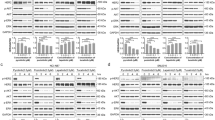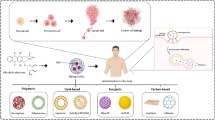Abstract
Introduction
MYCN amplification is highly associated with malignancy and correlates with poor prognosis in patients with neuroblastoma.
Materials and methods
We developed a novel liposome-MYCN siRNA-folic acid complex, and the transfection efficacy was measured in LA-N-5 cells by cy-3 fluorescence density in each microgram of protein from the transfected cell lysate. MYCN expression and cell growth were studied with quantitative RT-PCR and MTT assays, and the expression of MYCN protein was studied with Western blot, respectively. An SCID mouse model with subcutaneous LA-N-5 xenografted tumor was established. The animals were divided into four groups (n = 5) and they were peritoneally injected with liposome-encapsulated MYCN siRNA (siRNA 125 μg/kg/day), lipid-encapsulated control siRNA, MYCN siRNA, or liposome only, respectively, for 5 consecutive days. The animals were killed 24 h after the last injection, and the expression of MYCN mRNA in tumor tissue was detected by RT-PCR.
Results
Our results are as follows: the transfect efficacy reached 1808.5 ± 140.2 pg siRNA/μg protein in LA-N-5 lysates after treatment with 100 nmol/L MYCN siRNA encapsulated with lipid, and fluorescence could be visualized in 92% of LA-N-5 cells after transfection. At 72 h post-transfection, MYCN mRNA expression in LA-N-5 cells was downregulated by 79.2%, MYCN protein was downregulated by 71.3% and cell growth was inhibited by 66.2%, as measured by MTT assay. In the in vivo study, MYCN mRNA expression was knocked down 53.1% in tumor tissues with injection of liposome-encapsulated MYCN siRNA as compared to control siRNA.
Conclusion
These results suggest that targeted delivery of MYCN siRNA by folate receptor-targeted lipid vesicles into LA-N-5 cells is efficacious and capable of suppressing MYCN mRNA expression both in vitro and in vivo.




Similar content being viewed by others
Abbreviations
- NB:
-
Neuroblastoma
- siRNA:
-
Small interference RNA
- RNAi:
-
RNA interference
- ODN:
-
Oligonucleotides
- DSPC:
-
1,2-Distearoyl-sn-glycero-phosphocholine
- DODAC:
-
N-N-dioleyl-N-N-dimethylammonium chloride
- PEG-CerC16:
-
N-palmitoylsphingosine-1-[succinyl-(methoxypoly (ethylene glycol) 2000]
- FR:
-
Folate receptor
- dTd:
-
Thymidine residues
- PBS:
-
Phosphate buffered saline
- RT-PCR:
-
Transcription polymerase chain reaction
- hGAPDH:
-
Human glyceraldehyde-3-phosphate dehydrogenase
- DMSO:
-
Dimethyl sulfoxide
- SCID:
-
Severe combined immune deficient
- MTT:
-
3-[4, 5-dimethylthiazol-2-yl]-2, 5-diphenyltetrazolium bromide
References
Schor NF (1999) Neuroblastoma as a neurobiological disease. J Neurooncol 41:159–166
Westermann F, Schwab M (2002) Genetic parameters of neuroblastomas. Cancer Lett 184:127–147
Mukherjee B, Morgenbesser SD, DePinho RA (1992) Myc family oncoproteins function through a common pathway to transform normal cells in culture: cross-interference by Max and trans-acting dominant mutants. Genes Dev 6:1480–1492
Schwab M, Alitalo K, Klempnauer KH et al (1983) Amplified DNA with limited homology to myc cellular oncogene is shared by human neuroblastoma cell lines and a neuroblastoma tumour. Nature 305:245–248
Brodeur GM (2003) Neuroblastoma: biological insights into a clinical enigma. Nat Rev Cancer 3:203–216
Bown N (2001) Neuroblastoma tumour genetics: clinical and biological aspects. J Clin Pathol 54:897–910
Fire A, Xu S, Montgomery MK et al (1998) Potent and specific genetic interference by double-stranded RNA in Caenorhabditis elegans. Nature 391:806–811
Tijsterman M, Plasterk RH (2004) Dicers at RISC: the mechanism of RNAi. Cell 117:1–3
Kumar P, Ban HS, Kim SS et al (2008) T cell-specific siRNA delivery suppresses HIV-1 infection in humanized mice. Cell 134:577–586
Sioud M (2004) Therapeutic siRNAs. Trends Pharmacol Sci 25:22–28
Leamon CP, Low PS (1991) Delivery of macromolecules into living cells: a method that exploits folate receptor endocytosis. Proc Natl Acad Sci USA 88:5572–5576
Zhou W, Yuan X, Wilson A et al (2002) Efficient intracellular delivery of oligonucleotides formulated in folate receptor-targeted lipid vesicles. Bioconjug Chem 13:1220–1225
Lee RJ, Low PS (1994) Delivery of liposomes into cultured KB cells via folate receptor-mediated endocytosis. J Biol Chem 269:3198–3204
Rui Y, Wang S, Low PS et al (1996) Diplasmenylcholine-folate liposomes: an efficient vehicle for intracellular drug delivery. J Am Chem Soc 120:11213–11218
Gabizon A, Horowitz AT, Goren D et al (1999) Targeting folate receptor with folate linked to extremities of poly(ethylene glycol)-grafted liposomes: in vitro studies. Bioconjug Chem 10:289–298
Leamon CP, Weigl D, Hendren RW (1999) Folate copolymer-mediated transfection of cultured cells. Bioconjug Chem 10:947–957
Reddy JA, Dean D, Kennedy MD et al (1999) Optimization of folate-conjugated liposomal vectors for folate receptor-mediated gene therapy. J Pharm Sci 88:1112–1118
Reddy JA, Low PS (2000) Enhanced folate receptor mediated gene therapy using a novel pH-sensitive lipid formulation. J Control Release 64:27–37
Biewenga JE, Destree OH, Schrama LH (1997) Plasmid-mediated gene transfer in neurons using the biolistics technique. J Neurosci Methods 71:67–75
Pan XQ, Zheng X, Shi G et al (2002) Strategy for the treatment of acute myelogenous leukemia based on folate receptor beta-targeted liposomal doxorubicin combined with receptor induction using all-trans retinoic acid. Blood 100:594–602
Galderisi U, Di Bernardo G, Cipollaro M et al (1999) Differentiation and apoptosis of neuroblastoma cells: role of N-myc gene product. J Cell Biochem 73:97–105
Nara K, Kusafuka T, Yoneda A et al (2007) Silencing of MYCN by RNA interference induces growth inhibition, apoptotic activity and cell differentiation in a neuroblastoma cell line with MYCN amplification. Int J Oncol 30:1189–1196
Kim YH, Girard L, Giacomini CP et al (2006) Combined microarray analysis of small cell lung cancer reveals altered apoptotic balance and distinct expression signatures of MYC family gene amplification. Oncogene 25:130–138
Morgenstern DA, Anderson J (2006) MYCN deregulation as a potential target for novel therapies in rhabdomyosarcoma. Expert Rev Anticancer Ther 6:217–224
Mairal A, Pinglier E, Gilbert E et al (2000) Detection of chromosome imbalances in retinoblastoma by parallel karyotype and CGH analyses. Genes Chromosom Cancer 28:370–379
Pession A, Tonelli R (2005) The MYCN oncogene as a specific and selective drug target for peripheral and central nervous system tumors. Curr Cancer Drug Targets 5:273–283
Acknowledgments
We sincerely thank Dr Li S for providing the FR-targeted liposomes for our experiments. This research work was fully supported by grant from Chinese Natural Science Foundation, Permit No. 30471802 and Grant from China Project 863, Permit No. 2007AA021004.
Conflict of interests
The authors declare that they have no competing interests.
Author information
Authors and Affiliations
Corresponding author
Rights and permissions
About this article
Cite this article
Feng, C., Wang, T., Tang, R. et al. Silencing of the MYCN gene by siRNA delivered by folate receptor-targeted liposomes in LA-N-5 cells. Pediatr Surg Int 26, 1185–1191 (2010). https://doi.org/10.1007/s00383-010-2703-5
Accepted:
Published:
Issue Date:
DOI: https://doi.org/10.1007/s00383-010-2703-5




